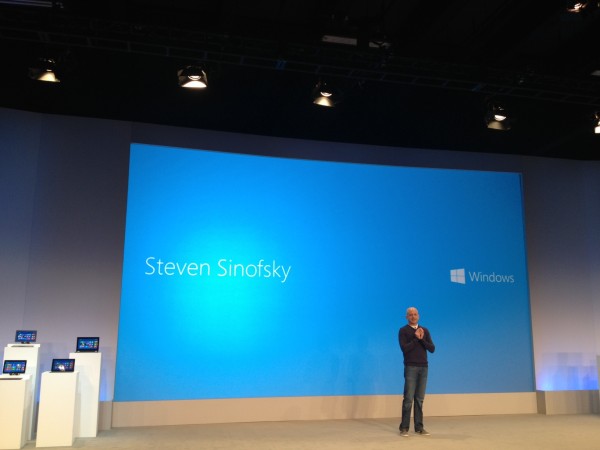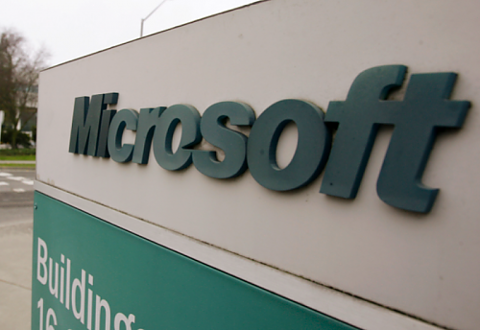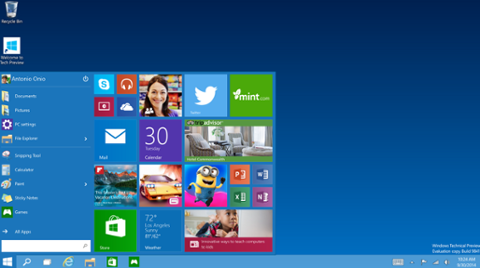 In a move that caught many outside observers off-guard, Windows division president Steven Sinofsky has resigned from Microsoft. No official explanation was given for his departure, although multiple publications cited his friction with other executives within the company as the primary reason. “It is impossible to count the blessings I have received over my years at Microsoft,” Sinofsky wrote in a widely circulated statement. “I am humbled by the professionalism and generosity of everyone I have had the good fortune to work with at this awesome company.” Sinofsky took the reins of the Windows division following the problematic launch of Windows Vista, which was widely maligned for everything from its hardware requirements to its DRM (digital rights management) restrictions. He spearheaded the development of Windows 7, which proved a massive success, and Windows 8, a radical revamp of the “traditional” Windows model. His departure comes mere weeks after Windows 8 launched on the open market. In the wake of Sinofsky’s departure, control over the Windows division is being split in two. Julie Larson-Green will head Windows engineering, while Tami Reller will lead the division’s business and marketing strategy. Both executives will report to Microsoft CEO Steve Ballmer. While Ballmer’s official statement on Sinofsky’s departure contains all the usual phrasings—“I am grateful for the many years of work that Steven has contributed to the company,” and so on—one section gives possible insight into the reasons behind Sinofsky’s departure. “We’ve built an incredible foundation with new releases of Microsoft Office, Windows 8, Windows Phone 8, Microsoft Surface, Windows Server 2012 and ‘Halo 4,’ and great integration of services such as Bing, Skype and Xbox across all our products,” Ballmer wrote. “To continue this success it is imperative that we continue to drive alignment across all Microsoft teams, and have more integrated and rapid development cycles for our offerings.” Place that statement alongside the news reports emerging in the wake of Sinofsky’s departure. Unnamed sources speaking to AllThingsD said that Sinofsky “was viewed at the top levels as not the kind of team player that the company was looking for,” and that tension between him and various top executives eventually led to his ouster. Sources also told The Verge that Sinofsky was “abrasive and off-putting, aggressively maintaining his control over products and putting up roadblocks.” If those sources are correct, then Sinofsky’s territoriality with his Windows division smacked hard against Microsoft’s broader attempt toward integration. But Sinofsky’s legacy will be felt for some time. Windows 8 is a radical departure from previous versions of the operating system, with a Start screen of colorful tiles linked to applications. In theory, that new user interface will allow the software to run on tablets (where the user can tap the tiles with a finger) or a traditional PC (where they can use the keyboard and mouse to navigate) with equal facility; for traditionalists and power users, there’s also a desktop accessible via a particular tile. It’s a sizable bet for Microsoft, and one that will stick around for years—long after Sinofsky lands on his feet somewhere new.
In a move that caught many outside observers off-guard, Windows division president Steven Sinofsky has resigned from Microsoft. No official explanation was given for his departure, although multiple publications cited his friction with other executives within the company as the primary reason. “It is impossible to count the blessings I have received over my years at Microsoft,” Sinofsky wrote in a widely circulated statement. “I am humbled by the professionalism and generosity of everyone I have had the good fortune to work with at this awesome company.” Sinofsky took the reins of the Windows division following the problematic launch of Windows Vista, which was widely maligned for everything from its hardware requirements to its DRM (digital rights management) restrictions. He spearheaded the development of Windows 7, which proved a massive success, and Windows 8, a radical revamp of the “traditional” Windows model. His departure comes mere weeks after Windows 8 launched on the open market. In the wake of Sinofsky’s departure, control over the Windows division is being split in two. Julie Larson-Green will head Windows engineering, while Tami Reller will lead the division’s business and marketing strategy. Both executives will report to Microsoft CEO Steve Ballmer. While Ballmer’s official statement on Sinofsky’s departure contains all the usual phrasings—“I am grateful for the many years of work that Steven has contributed to the company,” and so on—one section gives possible insight into the reasons behind Sinofsky’s departure. “We’ve built an incredible foundation with new releases of Microsoft Office, Windows 8, Windows Phone 8, Microsoft Surface, Windows Server 2012 and ‘Halo 4,’ and great integration of services such as Bing, Skype and Xbox across all our products,” Ballmer wrote. “To continue this success it is imperative that we continue to drive alignment across all Microsoft teams, and have more integrated and rapid development cycles for our offerings.” Place that statement alongside the news reports emerging in the wake of Sinofsky’s departure. Unnamed sources speaking to AllThingsD said that Sinofsky “was viewed at the top levels as not the kind of team player that the company was looking for,” and that tension between him and various top executives eventually led to his ouster. Sources also told The Verge that Sinofsky was “abrasive and off-putting, aggressively maintaining his control over products and putting up roadblocks.” If those sources are correct, then Sinofsky’s territoriality with his Windows division smacked hard against Microsoft’s broader attempt toward integration. But Sinofsky’s legacy will be felt for some time. Windows 8 is a radical departure from previous versions of the operating system, with a Start screen of colorful tiles linked to applications. In theory, that new user interface will allow the software to run on tablets (where the user can tap the tiles with a finger) or a traditional PC (where they can use the keyboard and mouse to navigate) with equal facility; for traditionalists and power users, there’s also a desktop accessible via a particular tile. It’s a sizable bet for Microsoft, and one that will stick around for years—long after Sinofsky lands on his feet somewhere new. Windows President Steven Sinofsky Leaves Microsoft
 In a move that caught many outside observers off-guard, Windows division president Steven Sinofsky has resigned from Microsoft. No official explanation was given for his departure, although multiple publications cited his friction with other executives within the company as the primary reason. “It is impossible to count the blessings I have received over my years at Microsoft,” Sinofsky wrote in a widely circulated statement. “I am humbled by the professionalism and generosity of everyone I have had the good fortune to work with at this awesome company.” Sinofsky took the reins of the Windows division following the problematic launch of Windows Vista, which was widely maligned for everything from its hardware requirements to its DRM (digital rights management) restrictions. He spearheaded the development of Windows 7, which proved a massive success, and Windows 8, a radical revamp of the “traditional” Windows model. His departure comes mere weeks after Windows 8 launched on the open market. In the wake of Sinofsky’s departure, control over the Windows division is being split in two. Julie Larson-Green will head Windows engineering, while Tami Reller will lead the division’s business and marketing strategy. Both executives will report to Microsoft CEO Steve Ballmer. While Ballmer’s official statement on Sinofsky’s departure contains all the usual phrasings—“I am grateful for the many years of work that Steven has contributed to the company,” and so on—one section gives possible insight into the reasons behind Sinofsky’s departure. “We’ve built an incredible foundation with new releases of Microsoft Office, Windows 8, Windows Phone 8, Microsoft Surface, Windows Server 2012 and ‘Halo 4,’ and great integration of services such as Bing, Skype and Xbox across all our products,” Ballmer wrote. “To continue this success it is imperative that we continue to drive alignment across all Microsoft teams, and have more integrated and rapid development cycles for our offerings.” Place that statement alongside the news reports emerging in the wake of Sinofsky’s departure. Unnamed sources speaking to AllThingsD said that Sinofsky “was viewed at the top levels as not the kind of team player that the company was looking for,” and that tension between him and various top executives eventually led to his ouster. Sources also told The Verge that Sinofsky was “abrasive and off-putting, aggressively maintaining his control over products and putting up roadblocks.” If those sources are correct, then Sinofsky’s territoriality with his Windows division smacked hard against Microsoft’s broader attempt toward integration. But Sinofsky’s legacy will be felt for some time. Windows 8 is a radical departure from previous versions of the operating system, with a Start screen of colorful tiles linked to applications. In theory, that new user interface will allow the software to run on tablets (where the user can tap the tiles with a finger) or a traditional PC (where they can use the keyboard and mouse to navigate) with equal facility; for traditionalists and power users, there’s also a desktop accessible via a particular tile. It’s a sizable bet for Microsoft, and one that will stick around for years—long after Sinofsky lands on his feet somewhere new.
In a move that caught many outside observers off-guard, Windows division president Steven Sinofsky has resigned from Microsoft. No official explanation was given for his departure, although multiple publications cited his friction with other executives within the company as the primary reason. “It is impossible to count the blessings I have received over my years at Microsoft,” Sinofsky wrote in a widely circulated statement. “I am humbled by the professionalism and generosity of everyone I have had the good fortune to work with at this awesome company.” Sinofsky took the reins of the Windows division following the problematic launch of Windows Vista, which was widely maligned for everything from its hardware requirements to its DRM (digital rights management) restrictions. He spearheaded the development of Windows 7, which proved a massive success, and Windows 8, a radical revamp of the “traditional” Windows model. His departure comes mere weeks after Windows 8 launched on the open market. In the wake of Sinofsky’s departure, control over the Windows division is being split in two. Julie Larson-Green will head Windows engineering, while Tami Reller will lead the division’s business and marketing strategy. Both executives will report to Microsoft CEO Steve Ballmer. While Ballmer’s official statement on Sinofsky’s departure contains all the usual phrasings—“I am grateful for the many years of work that Steven has contributed to the company,” and so on—one section gives possible insight into the reasons behind Sinofsky’s departure. “We’ve built an incredible foundation with new releases of Microsoft Office, Windows 8, Windows Phone 8, Microsoft Surface, Windows Server 2012 and ‘Halo 4,’ and great integration of services such as Bing, Skype and Xbox across all our products,” Ballmer wrote. “To continue this success it is imperative that we continue to drive alignment across all Microsoft teams, and have more integrated and rapid development cycles for our offerings.” Place that statement alongside the news reports emerging in the wake of Sinofsky’s departure. Unnamed sources speaking to AllThingsD said that Sinofsky “was viewed at the top levels as not the kind of team player that the company was looking for,” and that tension between him and various top executives eventually led to his ouster. Sources also told The Verge that Sinofsky was “abrasive and off-putting, aggressively maintaining his control over products and putting up roadblocks.” If those sources are correct, then Sinofsky’s territoriality with his Windows division smacked hard against Microsoft’s broader attempt toward integration. But Sinofsky’s legacy will be felt for some time. Windows 8 is a radical departure from previous versions of the operating system, with a Start screen of colorful tiles linked to applications. In theory, that new user interface will allow the software to run on tablets (where the user can tap the tiles with a finger) or a traditional PC (where they can use the keyboard and mouse to navigate) with equal facility; for traditionalists and power users, there’s also a desktop accessible via a particular tile. It’s a sizable bet for Microsoft, and one that will stick around for years—long after Sinofsky lands on his feet somewhere new. 

